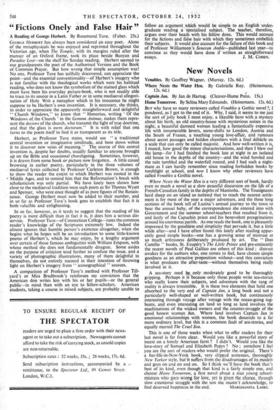" Fictions Onely and False Hair "
A Reading of George Herbert. By Rosemond Tuve. (Faber. 25s.) GEORGE HERBERT, has always been considered an easy poet.- Alone of the metaphysicals he was enjoyed and reprinted throughout the Victorian age, when The Temple, with its margins ruled after the manner of an Oxford frame, took its place beside Bunyan and Paradise Lost—on the shelf for Sunday reading. Herbert seemed to out grandparents the poet of the Authorised Version and the Book of Common Prayer. But how wrong that simple assumption was! No one, Professor Tuve has wilfully discovered, can appreciate the point—and the essential conventionality—of Herbert's imagery who is not familiar with the theological works which were his habitual reading, who does not know the symbolism of the stained glass which must have been his everyday picture-book, who is not readily able to trace to its source in a Latin Father or in some mediaeval allegori-- sation of Holy Writ a metaphor which in his innocence he might suppose to be Herbert's own invention. It is necessary, she thinks, in order to appreciate the apparently straightforward and delightful " Church Windows," to know that " Honorius, writing ' Of the Windows of the Church ' in the Gemma Animae, makes them repre- sent the doctors of the church, who transmit the light of true doctrine, and that the glass is mens doctorum." It is with relief that one turns to the poem itself to find it as transparent as its title.
Herbert, as Professor Tuve states, would use " a traditional central invention or imaginative similitude, and bore down within it to discover new veins of meaning." The source of this central invention is, despite her doubts, usually familiar to anyone brought up on the Bible and occasional churchgoing. Sometimes, however, it is drawn from some book or picture now forgotten. A little casual browsing in earlier poetry, particularly in the three volumes of mediaeval lyrics collected by Professor Carleton Brown, is enough to show the reader the extent to which Herbert was rooted in the • Middle Ages, and to remind him that the Reformation's break with scholasticism was only partial. We have lately been shown how close to the mediaeval tradition were such poets as Sir Thomas Wyatt and Spenser, who were once thought of as pure figures of the Renais- sance. George Herbert must now be added to their number, and in so far as Professor Tuve's book goes to establish that fact it is both valuable and enlightening.
so far, however, as it tends to suggest that the reading of his poetry is more difficult than in fact it is, it does him a serious dis- service. Professor Tuve—of Connecticut Collegerates the common reader's knowledge of the Scriptures extremely low. Indeed she almost ignores that humble person's existence altogether, when she begins what he hopes will be an introduction to some little-known poems of Herbert's, which he may enjoy, by a lengthy argument over certain of those famous ambiguities with William Empson, with whose method she does not fundamentally disagree. Some asides on the purpose of criticism tend further to confuse the issue, and a variety of photographic illustrations, many of them -delightful in themselves, do not entirely succeed in their intention of throwing light on Herbert's imagery from " iconographical " sources.
A comparison of Professor Tuve's method with Professor Till- yard's or Miss Bradbrook's reinforces my conviction that the American don writes less with his or her pupils—or the general public—in mind than with an eye to fellow-scholars. American students, taking a course in mixed subjects, are probably unable to follow an argument which would be simple to an English under- graduate reading a specialised subject. The teacher, therefore, argues over their heads with his fellow dons. This would account for the fictions and false hair with which they sometimes embellish their subjects. It would also account for the failure of.this book and of Professor Williamson's Senecan Amble—published last year—to convince as they would have done if written as straightforward


































 Previous page
Previous page